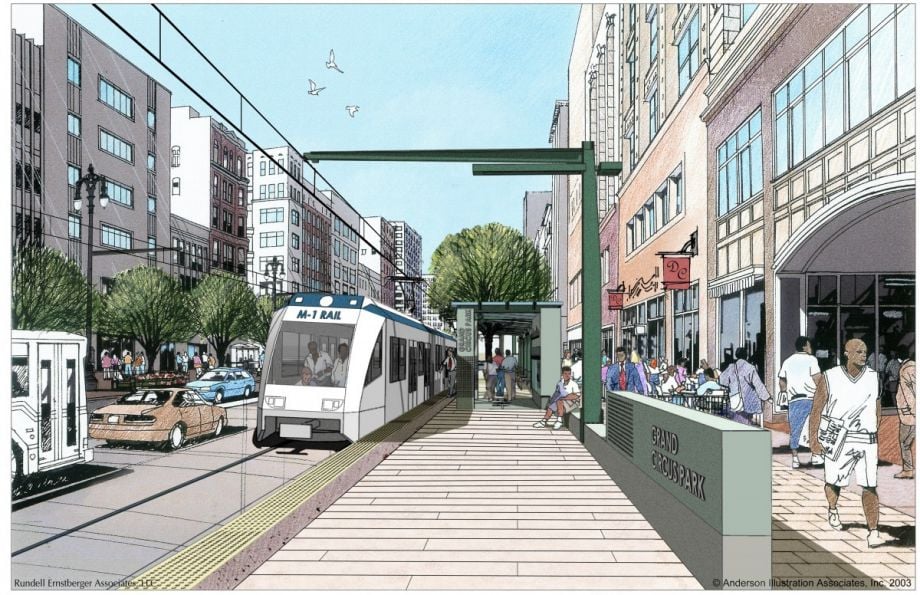Detroit has long been the city where rail transit plans go to die. That’s about to change: On July 28th, work begins on a new, three-mile-long modern streetcar line along Woodward Avenue, connecting the riverfront, downtown and the New Center-Midtown area. It’s not your run-of-the-mill modern streetcar, however.
What is the M-1 Rail Streetcar?
Let’s get this out of the way first: This is not a passenger version of the M-1 Abrams tank. The Boeing Vertol LRV debacle of the 1970s taught us all the perils of having defense contractors build rail cars.
The M-1 Rail Streetcar is a 3.3-mile-long central city circulator that will run on Woodward Avenue from Larned Street at the Detroit riverfront to Grand Boulevard in Midtown. It will have 11 stations and cost $137 million to build. It is projected to open in late 2016. At the same time, the Michigan Department of Transportation is rebuilding Woodward Avenue (also Michigan Route 1, hence the M-1 branding) at a cost of $35 million to $45 million.
That’s nice. But every city these days is building a streetcar of some kind. What makes this one such a big deal?
The M-1 is the first urban rail transit line in the country to be built and run by a private, non-profit organization, with most of the funding coming from private investors and foundations. According to the Detroit Free Press, the Kresge Foundation is the largest single funder of the line, donating $35 million of its cost. Another $9 million comes from the Downtown Development Authority. The Detroit Three automakers, Henry Ford Health System, Wayne State University, the Detroit Medical Center and other institutions located on or near the route have all chipped in as well. So has the Federal Transit Administration, to the tune of $25 million. Several local private investors have also contributed funds; the three most prominent are Roger Penske of Penske Corporation, Quicken Loans owner Dan Gilbert and Compuware founder Peter Karmanos.

Work zones for the M-1 streetcar project. (Source: m-1rail.com)
Do any of these people stand to benefit from the line’s construction?
The members of the M-1 Rail board — Penske is its chairman, Gilbert its vice chairman, and Matthew Cullen of Rock Ventures, another company founded by Gilbert, is its president and CEO — would no doubt tell you that the city of Detroit and the entire Detroit region will benefit from this project, and they’d be right. But Gilbert especially would see his investments in downtown Detroit appreciate as a result of the anticipated redevelopment associated with the line. Gilbert has placed huge bets on Downtown Detroit’s future, moving Quicken Loans headquarters there and buying scores of buildings large and small; his property management firm, Bedrock Real Estate Services, lists 34 downtown Detroit buildings in its portfolio.
Why is this project getting off the ground when so many others before it didn’t?
There have been a number of proposals to build rapid transit in Detroit in the past, dating back to a 1945 plan for a network of routes that would have been located in the medians of the city’s planned freeway system. The only facility that came out of these plans was the Detroit People Mover, a downtown circulator that was to have connected to a Woodward Avenue subway line as part of a 1970s transit plan. The M-1 Rail website FAQ states that Super Bowl XL, held in Detroit in 2006, served as a wake-up call, as the crowds that descended on the city found it difficult to get from the stadium to the city’s main entertainment areas by car or on the city’s bus system.
Its backers also tout the rail line as a catalyst for economic redevelopment in Detroit. The streetcar line is considered a key element in the Downtown Detroit Partnership’s plan to promote transit-oriented development in the city center.
Are there any losers in this effort?
If there are, they come from the city’s political class, which has largely been shut out of the streetcar development project. The Detroit Department of Transportation (DDOT), which operates the bus system in the city limits, and the Detroit City Planning Commission are both involved in the Downtown Detroit Partnership, and DDOT services will also come under the umbrella of the new Regional Transit Authority whose creation made federal funding for this project possible, but otherwise, the city’s elected leaders — already hobbled by federal investigations and the city’s bankruptcy — are nowhere to be found among the backers and promoters of this project.
The Works is made possible with the support of the Surdna Foundation.

Next City contributor Sandy Smith is the home and real estate editor at Philadelphia magazine. Over the years, his work has appeared in Hidden City Philadelphia, the Philadelphia Inquirer and other local and regional publications. His interest in cities stretches back to his youth in Kansas City, and his career in journalism and media relations extends back that far as well.
Follow Sandy .(JavaScript must be enabled to view this email address)





_600_350_80_s_c1.JPEG)











